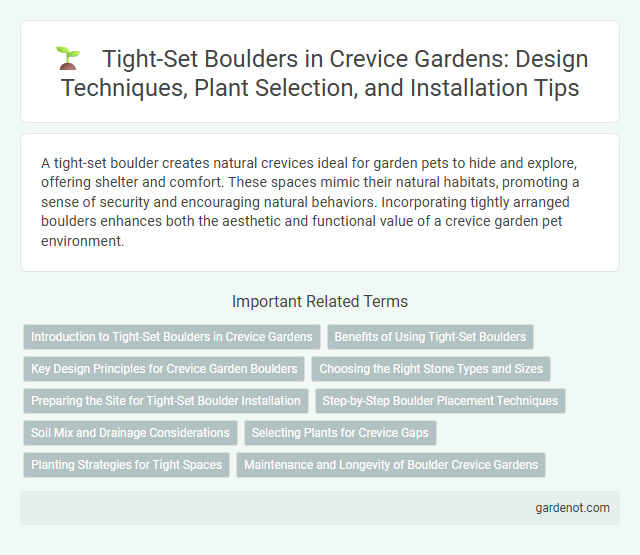A tight-set boulder creates natural crevices ideal for garden pets to hide and explore, offering shelter and comfort. These spaces mimic their natural habitats, promoting a sense of security and encouraging natural behaviors. Incorporating tightly arranged boulders enhances both the aesthetic and functional value of a crevice garden pet environment.
Introduction to Tight-Set Boulders in Crevice Gardens
Tight-set boulders in crevice gardens create narrow, closely spaced gaps that mimic natural rocky habitats. These formations enhance microclimates for alpine plants, improving drainage and root aeration essential for their survival. Utilizing tight-set boulders supports biodiversity by providing shelter and stability for specialized flora in crevice garden designs.
Benefits of Using Tight-Set Boulders
Tight-set boulders in crevice gardens create deep, narrow fissures ideal for alpine plants, enhancing moisture retention and root protection. Their close placement stabilizes the garden structure, reducing soil erosion and minimizing weed growth. This naturalistic arrangement also maximizes microclimates, supporting diverse plant species and promoting healthy growth.
Key Design Principles for Crevice Garden Boulders
Tight-set boulders in crevice garden design emphasize minimal spacing to mimic natural rock fissures, promoting microhabitats for alpine plants. Precise alignment and angular positioning enhance water drainage while providing structural stability and aesthetic ruggedness. Selecting varied stone sizes with rough textures supports diverse plant root anchorage and temperature regulation essential for crevice garden success.
Choosing the Right Stone Types and Sizes
Selecting tight-set boulders for a crevice garden involves prioritizing durable, weather-resistant stones such as granite, sandstone, or basalt that can withstand outdoor conditions while enhancing natural aesthetics. Opt for varied sizes, balancing larger foundational rocks with smaller accent stones to create realistic crevices that promote proper drainage and plant root growth. Properly sized and chosen boulders ensure structural stability and complement the garden's microclimate, supporting alpine and drought-tolerant plant species.
Preparing the Site for Tight-Set Boulder Installation
Clearing and leveling the site ensures a stable foundation for tight-set boulder installation in crevice gardens. Excavate the soil to the desired depth while maintaining proper drainage to prevent water accumulation around the boulders. Compacting the base layer with gravel or sand stabilizes the boulders, minimizing shifting and promoting long-term durability.
Step-by-Step Boulder Placement Techniques
Tight-set boulder placement in crevice gardens requires precise positioning to mimic natural rock formations and create stable crevices for plants. Step-by-step techniques include selecting boulders of varied sizes, arranging larger stones first to establish primary structure, and gradually filling gaps with smaller rocks to enhance stability and aesthetics. Proper alignment and angled placement ensure moisture retention and root protection, optimizing microhabitats for alpine and drought-tolerant plants.
Soil Mix and Drainage Considerations
Tight-set boulders in a crevice garden require a carefully designed soil mix that balances moisture retention with excellent drainage to prevent root rot and ensure plant health. A blend of coarse sand, gravel, and organic matter enhances aeration while maintaining adequate water flow through the soil. Proper drainage is achieved by layering gravel beneath the planting mix and positioning boulders to channel excess water away from sensitive root zones.
Selecting Plants for Crevice Gaps
Tight-set boulders in crevice gardens create narrow gaps ideal for alpine and drought-tolerant plants that thrive in minimal soil and restricted root space. Selecting species such as saxifrage, sedum, and thyme ensures effective root anchorage and moisture retention within these tight crevices. Optimal plant choices for these gaps emphasize low growth, high resilience, and adaptability to harsh microclimates created by densely placed stones.
Planting Strategies for Tight Spaces
Tight-set boulders in crevice gardens create narrow pockets that mimic natural rock fissures, providing ideal microhabitats for alpine and drought-tolerant plants. Strategic planting in these confined spaces involves selecting species with shallow root systems, such as saxifrages, sedums, and miniature ferns, which thrive in well-drained, nutrient-poor conditions. Maximizing soil aeration and moisture retention between boulders enhances plant establishment and growth, ensuring vibrant and resilient crevice garden displays.
Maintenance and Longevity of Boulder Crevice Gardens
Tight-set boulders in crevice gardens require minimal maintenance due to their stable placement, reducing soil erosion and weed infiltration. Properly fitted boulders enhance water retention and protect delicate plants by creating a microhabitat that mimics natural alpine conditions. Routine inspection for settling and occasional debris removal ensure the longevity and structural integrity of boulder crevice gardens over time.
Tight-set boulder Infographic

 gardenot.com
gardenot.com